Yamnuska and Climbing in the Land of Legends
A story written by Andy Genereux about climbing in the Canadian Rockies
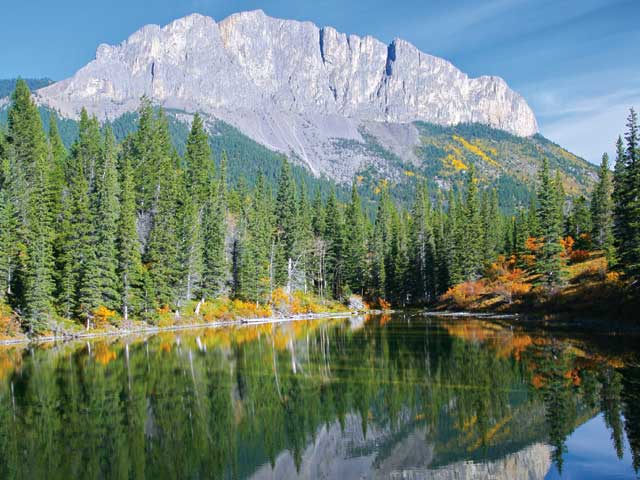
Mount Yamnuska over the years has remained the heartbeat of the rockies trad scene. This summer marked the 60th year for technical rock climbing in the Rockies and it all got started on this great cliff. The mountain has stood witness to four generations of climbers. Many firsts have kept the mountain at the leading edge in terms of grades and ethical standards.
I was climbing in the Ghost River recently with some climbers from Australia when they commented on how loose the rock was. I looked at them like they were crazy. “You think this is loose? I can show you loose. This is some of the best rock in the Rockies.” My new friends Doug and Di had just completed Bonanza 5.8+ one of the classic multi-pitch trad routes of the Canadian Rockies dating from the early 70s.
They still had to gain the local appreciation for the rock quality. In my mind, at the grade on local stone, it didn’t get much better. It’s a personal bias. I grew up and learned to climb here. It’s my backyard.
When I started rock climbing there was no such thing as sport climbing. All the existing climbs were traditional. Most were serious and almost everything was multi-pitch. Rockies climbing required a delicate limestone-touch. Back then you had to be a real climber. There was no hang dogging your way up a well bolted climb. Climbs were an adventure – they were not well groomed or preened. You went at it ground up, dealing with the unknowns.
The leader handled loose rock, bold runouts, to establish climbs. You hammered pitons and placed hexes and a few roped stoppers for gear. You climbed in big boots. Back then Mount Yamnuska was considered to be somewhat of a practice cliff for getting in shape for bigger alpine adventures elsewhere. Nearly all of the routes were daunting and serious.
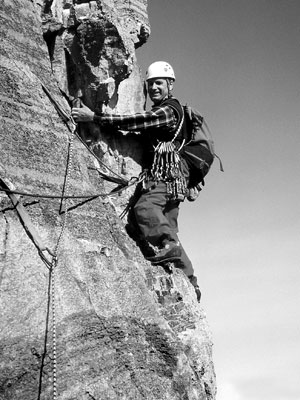
Back in 1975, when I was young, I was humbled and quaking below her rippled flanks of gold and grey stone. I was trying to decide on a climb for my first multi-pitch lead. I settled on Missionary’s Crack 5.10b, graded 5.9 back in the day. My partner and I flailed miserably as we approached up the massive scree descent. We did not know any better. Awestruck below this sheer south facing monolith, we walked slowly along the base looking for a possible line. It stood out…my mind quickly connecting several corners together. I simply decided to give it a go. We had no guidebook. We were just a couple of newbies, inexperienced high school kids with a rope, a few pitons and some machine nuts strung on cords. Finding a few fixed pitons increased our enthusiasm. By the end of the day, we had our growing youthful exuberance severely nipped in the bud.
Inadvertently we had chosen to tackle one of the hardest free climbs on the mountain at that time – a climb put up by Don Vockeroth and Brian Greenwood in 1964. It would take me three attempts, three partners and my first leader fall over the span of four years before I finally succeeded on this hallowed ground. Two years ago a 200-foot pillar fell off this climb, now nearly forty years after its inception it’s still a really serious and heady proposition. Maybe it can’t be climbed anymore. There is rock carnage covering lower ledges from the massive rockfall. I’m still too scarred to go and try. Until the face stabilizes maybe someone else with a death-wish can go and have a look.
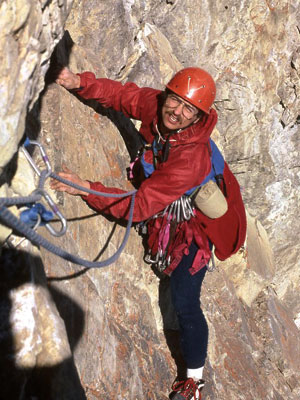
Despite this setback Mount Yamnuska over the years has remained the heartbeat of the rockies trad scene. This summer marked the 60th year for technical rock climbing in the Rockies and it all got started on this great cliff. The mountain has stood witness to four generations of climbers. Many firsts have kept the mountain at the leading edge in terms of grades and ethical standards. Back when I was a 16 and learning the ropes, this is where I explored and gradually earned my experiences. For me the legends of the game back then were guys like Brian Greenwood, Don Vockeroth, Urs Kallen, Billy Davidson, George Homer, and Jon Jones. I was lucky enough to meet them all at one time or another. Unfortunately I only got to climb with two of them.
It seems like everybody from this new generation feels they should all be climbing 5.12 as a warm up. They have the gyms and the training and the latest, lightest and spiffiest gear. Even though half of ’em couldn’t place gear or deal with loose rock if their life counted on it. Nobody seems much interested in the past. They don’t seem to care about the huge effort that went in to establishing these previous climbs. They seem to see little value in learning rock craft, being a well rounded climber, ticking off the classics working up through the grades eventually exploring their own adventures. Most of the kids today don’t realize the sacrifice and blood that has been spilled on these mountains to get the climbing game to where it is today in the Rockies, sport or traditional.
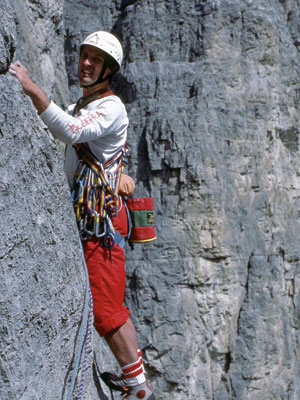
Technical rock climbing around here really got started on this great cliff back in the summer of 1952 with the ascent of Grillmair Chimney’s 5.6 by Leo Grillmair, Isabel Sprit, and Hans Gmoser. All were recent immigrants to Canada. This inaugural first climb would set in motion the notion that it was possible to actually climb these steep faces. This one climb eventually led to a steady advance in grades and the proliferation of many great climbs found today in the Rockies. This introduction of higher technical standards and the hard metal pitons used in Europe by this band of post war immigrants would be instrumental in getting the ball rolling. Leo and Hans would be joined by Heinz Kahl to establish Direttisima 5.8+ in 1957. This corner system leading directly to the summit of Yam was considered to be one of the most difficult rock climbs in North America at the time.
The efforts of this first migration of Europeans would be expanded by a second wave of climbers of predominately British extraction that would infuse and inspire the golden years of development in the Rockies through the 60s and 70s. During this period of sandbagging and one-upmanship most of the obvious corner/crack lines on the accessible faces were exploited. Free climbing grades eventually flatlined at around 5.9. This mostly occurred because climbers could not protect outside these obvious corner features. Bolts were, for the most part, shunned and eventually this ethical policy lead to a compression and stagnation of grades and new route development dwindled by the end of the era. There were only so many corner/crack systems around.
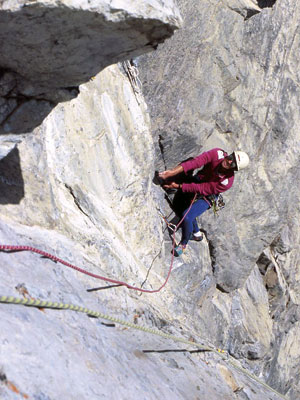
Along the way this second group of expats would suck a few local lads into their vortex with the addictive highs of the CMC parties and the allure of pushing new routes. Don Vockeroth, and Tim Auger were two notable examples from this period. Their route Kahl Wall 5.10a was the first to connect blanker face sections with intermittent corner systems using bolts – a novel idea back in 1971. Although it would be the next wave of climbers that would eventually free the bits of aid on this route. The idea of exploring the blank faces on Yamnuska was first mentioned in the mid-60s by Brian Greenwood one of the early masters of the Rockies scene. Greenwood was one of the first to employ aid bolts to overcome short technical difficulties on Corkscrew 5.8 A0 and Balrog 5.10b. By 1972 his ideas had expanded and gained some merit. Big wall styled routes like CMC Wall 5.11b and Yellow Edge 5.11b by local lad Billy Davidson and Swiss born climber Urs Kallen had proven that the steepest ground could be overcome. Now all that was needed was the spark to push free climbing standards upward. By the early 80s there was a youth movement overtaking the local scene. Canadian born climbers were not just a sidebar to the Europeans, they started taking centre stage.
In 1977 the route that would solidify the potential for attacking these blanker faces was the Maker 5.10c located in the CMC Valley behind Yamnuska. Two Canadian born youths, John Lauchlan and Bruce Keller, would push this amazing line up the Ripple Wall using the minimum of bolt protection. The genie was out of the bottle so to speak and Rockies climbers would continue to expand on this concept over the next two decades as the faces got steeper and the holds ever smaller.
The bold 80s would witness landmark ascents. Free climbing grades would rise dramatically and the number of hard routes being established would explode. The decade would also bring forth unforeseen tragedy and heartache amongst the Rockies climbing fraternity.
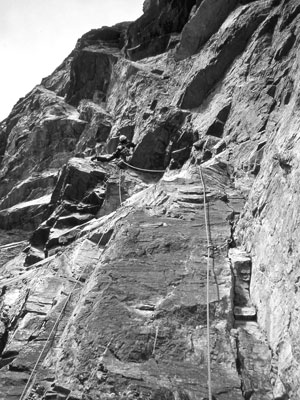
The climb that would set the stage for what was possible on big rock routes occurred in 1984 with the free climbing of CMC Wall at 5.11b by Brian Wallace and Bill Stark. Their amazing one-day fee ascent of this seminal aid route broke the game wide open. Afterwards anything seemed possible. Their bold adventure would head up nearly a decade of hard climbing out on the edge. Unfortunately by the end of the decade several of the leading activists would be dead, killed while chasing their passions. The aftermath would see other important contributors leave climbing altogether. It was a massive price to pay. The halcyon days of my youth seemed shattered forever.
One of the positive outcomes of this frantic period was the invention and acceptance of sport climbing during the mid-80s. Eventually aspects of this new climbing game would evolve and become accepted elements on bigger traditional routes. Climbers were not willing to risk all for a piece of rock anymore. Power drills, beefy bolts and the rise of technical grades evolved from the sport climbing revolution. This process was neither smooth nor easily accepted, but as the popularity of sport climbing grew, it was obvious that these practices would eventually expand out onto the all big faces of the Rockies.
By the end of the 80s, grades had once again flatlined at hard 5.11, but on Yam it was always serious. The hand drilling off hooks and the bold routes of the 80s had very much run their course. Bolts were now commonly being used, just not very many. Much of the enthusiasm and gains achieved at the start of the decade lay in tatters following the deaths of leading climbers Brian Wallace, John Lauchlan, Dave Cheesmond and Mark Deleeuw. Jeff Marshall and Steve De Maio two of the main protagonists of this era never quite regained their drive and enthusiasm after the death of Wallace on the North Face of Mount Lougheed in 1988. Bill Stark, Wallace’s partner from the pivotal CMC Wall free climb had also drifted away from the sport as had Bruce Keller. With such tragic loss it was like having the heart ripped out of the beast.
The 90s saw a steady increase in the number of big routes being establised in the Bow Valley. However, only a handful of activists were responsible. The first 5.12 routes were established on Yamnuska. Two things had allowed for this breakthrough. The better protection standards found in sport climbing had finally begun to find their way onto the bigger routes and the use of a power drill on lead to speed up and improve the quantity and quality of the fixed gear. The first use of a power drill on Yam while leading occurred on CMC Direct 5.11b, a four-pitch variation to CMC Wall that was established over a few hours by me and Jon Jones. This breakthrough showed that it was possible to establish difficult new terrain efficiently and relatively safely. This trend would continue on other landmark routes like Snert’s Big Adventure 5.11d, which was my first climb employing rope soloing with a power drill. It continued on the free climb of the challenging East End Boys at 5.12a, which was retrofitted on lead with a power drill. We replaced the 30-year old quarter- inch bolts on the first couple of pitches, removed piles of loose rock to improve free climbing and added fixed bomber belays.
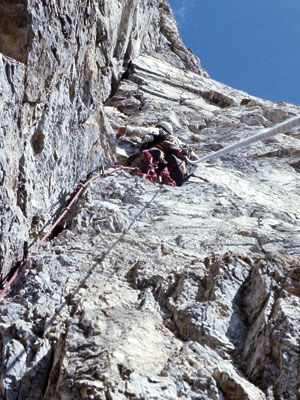
Today Yamnuska, like much of the Rockies has a wide variety of climbing styles that meld together to make up the modern traditional climbing game. This wouldn’t have been possible without those who came before us and their innovations, ethical advances, hard work and sacrifices. The legends of the game still clearly march on in my mind; I think back to Leo Grillmair as he launched himself up that final chimney 60 years ago. He had crepe soled shoes with holes through to his socks and nothing more than a clothesline securing him to his partners….the uncertainty of it all. I think quietly to myself we owe so much to our past. We owe.


